How should you change your brand marketing strategy during a crisis? We’ll share some detailed insight in our latest post.
What do you talk about when everyone is talking about COVID-19?
Brand marketing during a crisis is always tough. But when the crisis is as unprecedented as the current one, striking the right balance can be nigh near impossible.
Do you pretend that everything is alright and it’s business as usual? Or do you strike a happy tone and become a beacon of positivity?
The right path is seldom clear.
Instead of ad-hoc campaigns, you need a robust strategy to guide your brand marketing during a crisis. In this post, I’ll share the dos and don’ts of crisis brand marketing, and how to thrive through the current one.
What Not To Do
As much as it is important to do the right thing, it is even more important to not do the wrong things.
Case in point: Spirit Airlines’ “Never a Better Time to Fly” campaign. The ad was on an automated schedule but was sent out just as much of the world was shutting down.
Given the context, the message was not only poorly timed, but also insensitive.
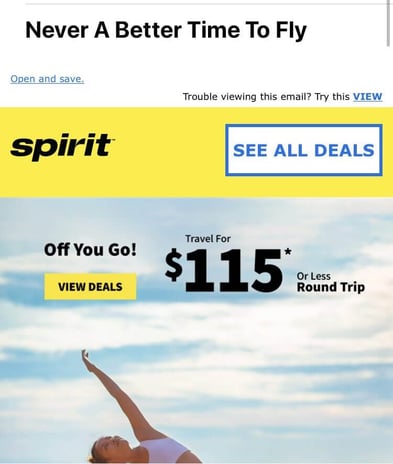
By and large, there are three pitfalls you absolutely need to avoid:
1. Ignore the Crisis
It can be tempting to pretend that nothing is really going on and everything is moving as planned. This can create a sense of normalcy - a scarce quantity in a time like this.
But ignoring the crisis can lead to situations where your brand is deemed insensitive or opportunistic.
For example, in March, Geico aired a new ad, “Perfect High Five”. The ad featured a lot of close physical contact, including two giant hands giving each other a “high five”.
2. Exploit the Crisis
If ignoring the crisis isn’t an option, neither is willfully exploiting it. Campaigns that focus entirely on leveraging COVID-19 to increase sales can be seen as insensitive.
Here’s one egregious example from ASOS which advertised a chainmail mask - an ineffective product that makes light of the real shortage of medical supplies.
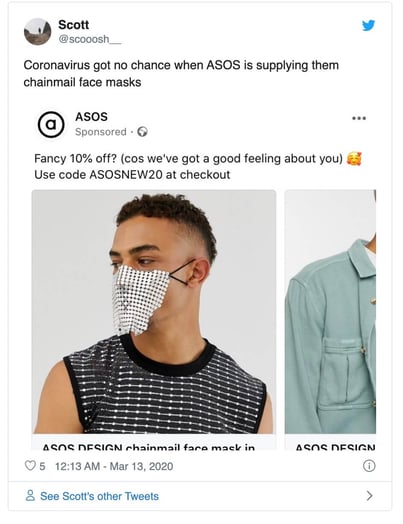
Even campaigns that circuitously reference COVID-19 to boost sales can spark outrage.
For example, at the beginning of March, Lysol aired a new ad that focused on the disinfectant’s germ fighting capabilities. The ad featured a child wiping his nose on a toy - a rather horrifying scenario in the present context - and the mother disinfecting it with Lysol.
At a time when demand for Lysol is already much higher than usual, the campaign felt ill-conceived and ill-timed.
3. Be Overly Positive
Positivity is a pillar brand marketers often cling onto in times of crisis. After all, being the spark of positivity in a sea of negative stories makes sense - at least on paper.
However, positivity as a campaign tentpole fails when the scope of the crisis is immense, as is the case with COVID-19. Apart from the sheer medical toll, millions of people have lost their jobs and countless businesses have been disrupted.
Overt positivity - especially when it’s peppered with feel-good sentimentality - can backfire.
While positivity is important, it has to be finely calibrated - as we’ll discuss below.
What To Do: 5 First Steps in a Crisis
Now that we have a list of things not to do, let’s look at the opposite - what should you do when a crisis strikes?
Much depends on the kind of crisis you’re dealing with. If the crisis has predictable movements and outcomes, you can plan ahead of time. But if the outcome, duration, or even cause is uncertain - as is the case with COVID-19 - you have to adopt a hands-on approach.
Before you start formulating a strategy, here are the first five steps you need to follow:
- Pause all existing campaigns across all channels
- Review all marketing collateral for tone, message, offer, and appropriateness
- Stop campaigns on channels with low impact or uptake during the crisis - such as billboard ads during a lockdown
- Pause all production of high-cost creative collateral (such as a TV ad) until you get a better understanding of the crisis.
- Create a rolling marketing plan, incorporating the latest developments in the crisis. Focus on channels that support cheap, easily modifiable collateral such as social media.
A crisis is not the time to be irreverent. I know it sounds very risk-averse, but you should be willing to hit the brakes on any campaign that might be construed as insensitive or tone-deaf.
A crisis like this is unprecedented. Your customers have a lower tolerance for egregious campaigns. You can erode brand equity quickly with a single ill-conceived campaign.
Once you’ve paused all campaigns and evaluated your collateral, it’s time to chart your strategy for the next several months.
Creating a Confident Brand Marketing Strategy
Brand marketing during a fast-moving crisis like COVID-19 can be a minefield. You have to strike a fine balance between meeting your marketing goals while still being sympathetic to the worries and sufferings of your customers.
It’s a tightrope act and one that many brands fail to do.
Below, I’ll share some guidelines for charting a more confident and impactful brand marketing strategy during a crisis.
1. If you have nothing interesting to say, just show your support
When every brand around you is launching a COVID-19 themed campaign, it can be tempting to join the bandwagon.
More often than not, however, your campaign will just get lost in the crowd. Customers have more worries right now than digging through dozens of similarly themed COVID-19 emails and ads.
If you don’t have anything interesting to say, don’t say anything at all.
But does this mean you have to pretend that everything is fine?
Not quite. A simple message of support and appreciation for the people most impacted (like frontline workers) is a good first step. If you can match it with a donation to a proven charity, even better.
This approach works particularly well for brands whose customers might not be immediately impacted by the crisis.
For example, luxury brand Gucci pinned this tweet of support to frontline workers and followed it up with a donation:
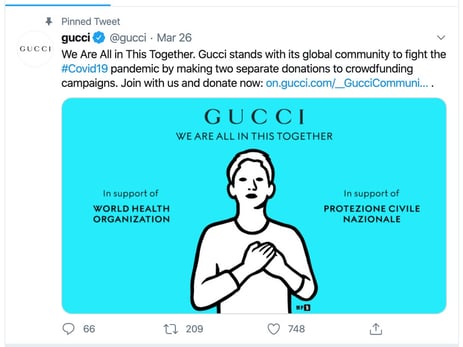
2. When in doubt, rally around noncontroversial topics
Emotions run high during a crisis. Certain topics inevitably attract controversy. For a risk-averse brand, such controversial topics are a no go.
The alternative is to rally around topics that few, if anyone, can find fault with. Things like family, kids, pets are safe bets. They also have universal appeal, especially in a time of crisis.
If you can tie these topics to a peculiar feature of the current crisis, even better.
For example, Bonobos cleverly references the video chat galleries so many of us have used during this crisis, but with adorable dogs.
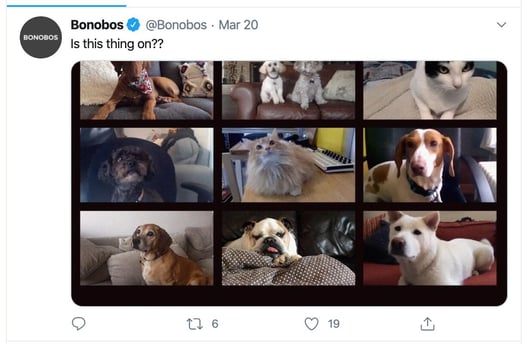
This is a safe brand marketing strategy. You’re unlikely to offend anyone, and everyone likes seeing pets on their social media timeline.
3. If possible, offer material support
Saying that you support frontline workers is nice, but what if you take things a step further?
Charitable donations and material support are a great way to show that you care. The latter is particularly impactful - it helps you stand out from generic campaigns and gives the people who matter real support on the ground.
For example, Louis Vuitton diverted its considerable resources towards manufacturing masks for frontline workers. For a luxury brand to retool its capabilities to make masks is a commendable gesture.
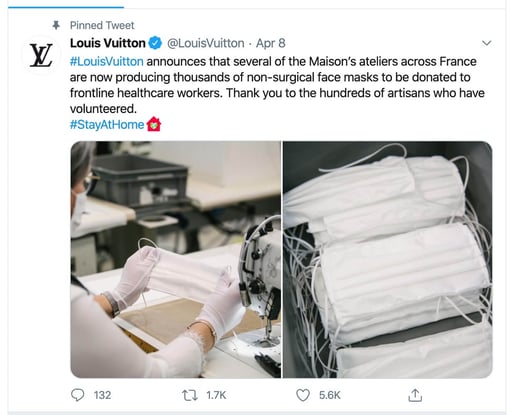
4. Offer empathy and hope, not just positivity
Saccharin sweet positivity, as I mentioned earlier, can come across as tone deaf. People who have lost jobs and loved ones don’t want to see a “Everything is great!” message. They want to know that they’re being heard and that they have something to look forward to.
Hope and empathy should be the underpinnings of any campaign that you undertake. Show customers that you’re there for them. If you can offer something more than words to demonstrate this, you’ll win big favors with customers.
Ford did this particularly well at the onset of the outbreak. It offered customers an option to delay their payments for up to 90 days. It also set aside a substantial amount to help vulnerable groups in Michigan.
It’s not big and splashy, but it shows customers that you care.
5. Leverage emerging trends
The COVID-19 crisis has greatly accelerated the growth of trends such as virtual chat rooms, remote work, and live streaming. Incorporating them into your brand marketing can be a smart strategy, especially if you pair them up with noncontroversial topics.
Chipotle’s social media strategy is a goldmine of inspiration. The company has been using everything from Zoom hangouts to Twitch streaming to bolster its offerings. It has also paired up these campaigns with a substantial charitable drive.
At a time when the restaurant industry is struggling, this helps Chipotle standout - and makes sure that it retains top of mind attention.
For example, knowing that more and more people are gaming (and watching others gaming) during the lockdown, Chipotle jumped on Twitter and hosted a gaming challenge.
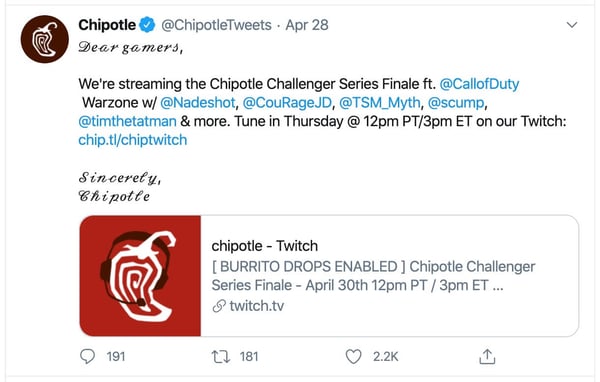
A few days later, Chipotle hosted an “afterparty” on Instagram Live and gave away $25k in scholarships.
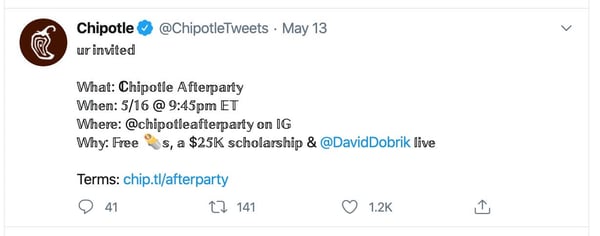
Campaigns like these work because they place your brand right where the audience is during the crisis, they leverage presently popular trends, and most importantly, they make sure that your brand isn’t forgotten during the crisis.
Which brings us to an important crisis marketing concern…
6. Be where your customers are
I know this sounds like Marketing 101, but it’s something a lot of brand marketers tend to overlook.
Consumption patterns are simply not the same during a crisis - especially in a crisis like COVID-19.
People aren’t driving on the roads (and hence, listening to the radio). They aren’t reading as many magazines and newspapers for fear of infection. There are no cinemas, malls, or events open.
At times like these, your marketing dollars need to be where your customers are. And in most cases, these customers are online.
Specifically, focus on channels that are seeing massive growth right now, such as:
- Live Streaming (Twitch, Instagram Live, Facebook Live, YouTube Live, etc.)
- Channel-specific short-form video content (<15s for TikTok, <10m for YouTube, etc.)
- Live chats and hangouts
- eSports
Some of these might be entirely new to you, but if there is any time to experiment, it’s now.
7. Be prepared to change on the fly
A global crisis like COVID-19 is seldom stable. New developments will change how your customers behave. You might see demand surge, prices drop, and consumer flight to new channels.
Make sure that your brand marketing strategy is flexible enough to accommodate these changes. Don’t buy into any plan so much that you can’t work your way out of it.
In particular, avoid spending too much on expensive collateral - the present conditions might not last long enough to make it profitable.
Keep one ear to the ground and be prepared to change with circumstances.
Over to You
I’ve said this twice already, but I’ll repeat it again: the present COVID-19 crisis is truly unprecedented. Brand marketing during such times requires a complete overhaul of your existing approach.
Follow these tactics to market your brand confidently in this crisis - or any other.
To be even more confident, switch your creative and marketing teams to an all-in-one management software like Workamajig. Workamajig will give you better insight into your operations, help you cut costs, and make more meaningful decisions.
Try out Workamajig today - just click the link below.
